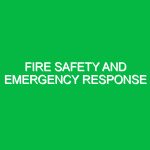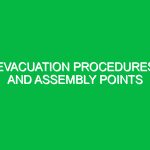Fire extinguishers are critical tools for managing fire emergencies, offering a first line of defense against small fires that could escalate into catastrophic events. Understanding using fire extinguishers is essential in the context of Health, Safety, and Environment (HSE) management, as they play a pivotal role in protecting lives, property, and the environment. In this comprehensive guide, we will explore the significance of fire extinguishers, the hazards associated with their use, the necessary precautions, best practices, and pertinent regulations.
The Importance of Fire Extinguishers in HSE
Using fire extinguishers effectively is not merely a matter of compliance; it’s about fostering a culture of safety within organizations. Every year, thousands of fires occur in workplaces, causing injuries, fatalities, and significant financial losses. According to the National Fire Protection Association (NFPA), U.S. fire departments responded to an estimated 1.3 million fires in 2020, resulting in $21.9 billion in property damage. These statistics underline the importance of being prepared with the right fire safety equipment and knowledge of how to use it.
Incorporating fire safety training into HSE protocols ensures that employees are equipped with the skills necessary to respond to fire emergencies. This proactive approach not only protects individuals but also enhances overall organizational resilience. For example, a manufacturing plant in Ohio implemented regular fire drills and training on using fire extinguishers, resulting in a 40% reduction in fire-related incidents over three years (source: NFPA).
Identifying Hazards and Risks Associated with Using Fire Extinguishers
While fire extinguishers are lifesavers, improper use or lack of understanding can lead to dangerous situations. Here are some potential hazards and risks associated with using fire extinguishers:
1. Type of Fire
Different fires require different extinguishing agents. Using the wrong type of extinguisher can exacerbate a fire. For instance, using a water extinguisher on an electrical fire can lead to electrocution, while applying foam on a grease fire can cause it to spread. It’s crucial to identify the class of fire (A, B, C, D, or K) and select the appropriate extinguisher.
2. Lack of Training
Many individuals may not have received adequate training on how to use fire extinguishers. In a panic-filled situation, even a simple task like pulling the pin can become overwhelming. According to a survey conducted by the Occupational Safety and Health Administration (OSHA), only 25% of workers have received formal fire safety training. This gap in knowledge can lead to ineffective responses during emergencies.
3. Accessibility Issues
Fire extinguishers must be easily accessible in case of an emergency. If they are blocked, misplaced, or out of reach, their effectiveness diminishes. Regular inspections and maintenance should be conducted to ensure that extinguishers are in their designated locations and are operational.
Safety Precautions and Best Practices for Using Fire Extinguishers
To mitigate the risks associated with using fire extinguishers, it’s essential to follow certain safety precautions and best practices. Here are some actionable steps to consider:
1. Know Your Extinguisher
Familiarize yourself with the different types of fire extinguishers and their classifications. Each extinguisher is marked with a label indicating its suitability for specific classes of fire. For example, a Class A extinguisher is effective against ordinary combustibles, while a Class B extinguisher is designed for flammable liquids. Understanding these classifications allows for informed decisions during a fire emergency.
2. Training is Key
Regular training sessions should be conducted to ensure that all employees know how to use fire extinguishers properly. Training should include hands-on practice, allowing individuals to become comfortable handling extinguishers. According to the NFPA, organizations that conduct regular fire drills and training see a significant improvement in emergency response times.
3. The PASS Technique
One effective way to remember how to use a fire extinguisher is the PASS technique:
- Pull: Pull the pin at the top of the extinguisher.
- Aim: Aim the nozzle at the base of the fire.
- Squeeze: Squeeze the lever slowly to release the extinguishing agent.
- Sweep: Sweep the nozzle from side to side until the fire is out.
This simple acronym can be a lifesaver during a fire emergency, ensuring a clear and effective response.
4. Assess the Situation
Before attempting to fight a fire, assess the situation carefully. If the fire is spreading rapidly or if smoke is filling the area, evacuate immediately and call for professional help. Never put yourself or others at risk; your safety should always come first.
5. Regular Maintenance and Inspections
Fire extinguishers require regular maintenance to ensure they function correctly when needed. Organizations should establish a maintenance schedule that includes annual inspections by certified professionals. Additionally, employees should perform monthly checks to ensure extinguishers are charged and accessible.
Regulations and Standards Governing Fire Extinguishers
Understanding the regulatory framework surrounding fire extinguishers is crucial for organizations seeking to comply with HSE standards. Key regulations include:
1. OSHA Regulations
The Occupational Safety and Health Administration (OSHA) has established regulations for fire safety, including the proper placement and maintenance of fire extinguishers. Employers are required to provide portable fire extinguishers in the workplace and ensure that employees have access to training.
2. National Fire Protection Association (NFPA) Codes
The NFPA sets forth codes and standards related to fire safety, including NFPA 10, which specifically addresses the selection, installation, and maintenance of portable fire extinguishers. Compliance with these codes ensures that extinguishers are effective and accessible.
3. Local Fire Codes
In addition to federal regulations, local fire codes may impose additional requirements regarding fire extinguisher placement and maintenance. It’s essential for organizations to consult their local fire department to ensure compliance with specific regulations in their area.
Conclusion
Using fire extinguishers is a critical skill in the realm of Health, Safety, and Environment (HSE). By understanding the types of fire extinguishers, recognizing potential hazards, and adhering to safety precautions, individuals can effectively protect themselves and their surroundings from fire emergencies. Regular training, maintenance, and adherence to regulations are vital components of a robust fire safety program. Remember, in the face of a fire, your knowledge and preparedness can make all the difference. Stay informed, stay trained, and above all, prioritize safety.


